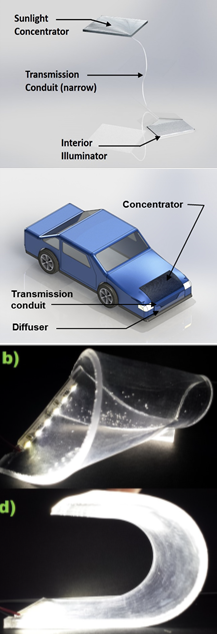
Flexible Optical Waveguide Sheets

Large-area optical waveguides are a new technology that may significantly impact the future of wearable devices for light harvesting, optically based biosensors in healthcare, flexible displays on clothing, sunlight capture systems for passive indoor lighting, signature and safety lighting on motorized vehicles, and non-planar solar concentrators. These devices are constructed from one or more optically transparent polymer sheets with thicknesses measured in millimeters and surface areas that range of from a few cm2 to several m2. Regions of the functionalized waveguide surface can be designed to act as either light concentrators (collectors), light diffusers (illuminators), and/or high efficiency light transmission conduits that perform like a fiber optic strand.
These thin polymer layers are constructed from materials that can be bent or even modestly stretched without fracturing or losing their optical properties. The optical performance of the large area waveguide is a function of the location and geometry of the micro-optical structures (MOSs), thickness and shape of the flexible waveguide, refractive indices of the constituent layers, and the characteristics of the incident light source. The non-rigid nature of the large area waveguide means that it can rest upon surfaces with arbitrary geometry.
Collaborating Researcher: Dr. Evgueni Bordatchev (NRC-IMI, London)